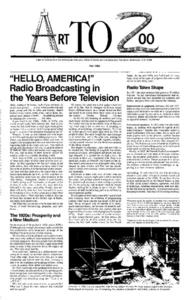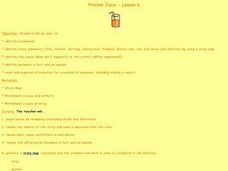Curated OER
Hiccup, Hiccup Go Away
Students discuss how the world of Mother Goose is full of sign, charms, and fortune telling, supplying advice on how to deal with life's events. They view a poster of "Hiccup, Hiccup." Students are asked if they have ever had hiccups....
Curated OER
Spot the Differences
In this spot the difference worksheet, students analyze pictures of two different wallabies to see if they can find six differences between the two.
Curated OER
Spot the Differences
In this spot the difference worksheet, students analyze pictures of two
different alligators to see if they can find six differences between the
two.
Curated OER
Spot the Differences
In this spot the difference worksheet, students analyze pictures of two
different water striders to see if they can find five differences between the
two.
Curated OER
Spot the Differences
In this spot the difference worksheet, students analyze pictures of two
different crabs to see if they can find five differences between the
two.
Curated OER
Spot the Differences
In this spot the difference worksheet, students analyze pictures of two
different green darners to see if they can find six differences between the
two.
Curated OER
Spot the Differences
For this spot the difference worksheet, students analyze pictures of two
different creeping thistles to see if they can find six differences between the
two.
Curated OER
Spot the Differences
For this spot the difference worksheet, students analyze pictures of two
different easter snake-necked turtles to see if they can find five differences between the
two.
Curated OER
Spot the Differences
For this spot the difference worksheet, students analyze pictures of two
different white-tailed deer to see if they can find six differences between the
two.
Curated OER
Spot the Differences
In this spot the difference worksheet, students analyze pictures of two
different dinosaur scenes to see if they can find ten differences between the
two.
Curated OER
Spot the Differences
In this spot the difference worksheet, students analyze pictures of two
different bird images to see if they can find ten differences between the
two.
Curated OER
Spot the Differences
In this spot the difference worksheet, students analyze pictures of two
different water animal images to see if they can find ten differences between the
two.
Curated OER
Radio Broadcasting Before Television
Students compare the radio to other forms of mass communication. In this Radio Broadcasting Before Television lesson, students learn the different types of radio shows in the 1920s and 30s. Students write and perform radio scripts...
Curated OER
Homonyms-Fill-In-The-Blank
In this homonyms worksheet, students choose the correct homonym to complete a set of 10 sentences. A reference web site is given for additional activities.
Curated OER
Learning About Writers
Young scholars explore how authors write stories. For this careers lesson, students invite an author into the classroom and ask him/her questions about writing as a career.
Curated OER
Library Media
Fifth graders find or shelve books in the library. For this library books lesson, 5th graders find books and learn how to shelve books in the library.
Curated OER
Freckle Juice- Lesson 6
Students read Freckle Juice. In this comprehension lesson, students complete a story map and discuss cause and effect based on readings from Freckle Juice.
Curated OER
Questions 10: Chapters XXVII-XXIX: Pages 56-95
In this reading comprehension worksheet, students answer 12 short essay questions that pertain to chapters 27-29. The name of the book is not specified, but it appears to be How to Eat Fried Worms by Thomas Rockwell.
Curated OER
Patterns to the Rescue
Students watch the Cyberchase episode, "The Poddleville Case" and play online games to examine how patterns are sequences that repeat or change in an orderly way. The lesson culminates with students creating their own patterns to use in...
Curated OER
Woodland Animals and Their Habitat
Students explore the natural environment through a video and nature sounds tape. They keep journal's of the unit's activities and vocabulary terms. They play a web of interdependence game and compose a list of forest animals and write...
Curated OER
Food Labels
Students study Nutrition Facts labels. In this life science lesson plan, students explore Nutrition Facts labels, then determine and analyze the nutrients found in a variety of foods. Additionally students construct bug boxes used to...
Curated OER
Can You Measure Up?
Young scholars use technology to visit websites where they play interactive games, gather information to complete activity sheets, and complete online projects. One lesson plan using 'Inch By Inch' by Leo Lionni, takes students to an...
Curated OER
Scavenger Hunt for Coins of the World--New Zealand, Japan and France!
Students explore the history, culture and currency of the countries they "visit" using the US Mint Coins of the World activity. Students find the answers to a Scavenger Hunt Questions handout for the country being studied. Students...
Curated OER
Understanding Quantities 2
In this language arts worksheet, learners learn to use appropriate nouns when describing quantities. Students read the beginning of a phrase and add an appropriate noun. Example: A glass of ___

























